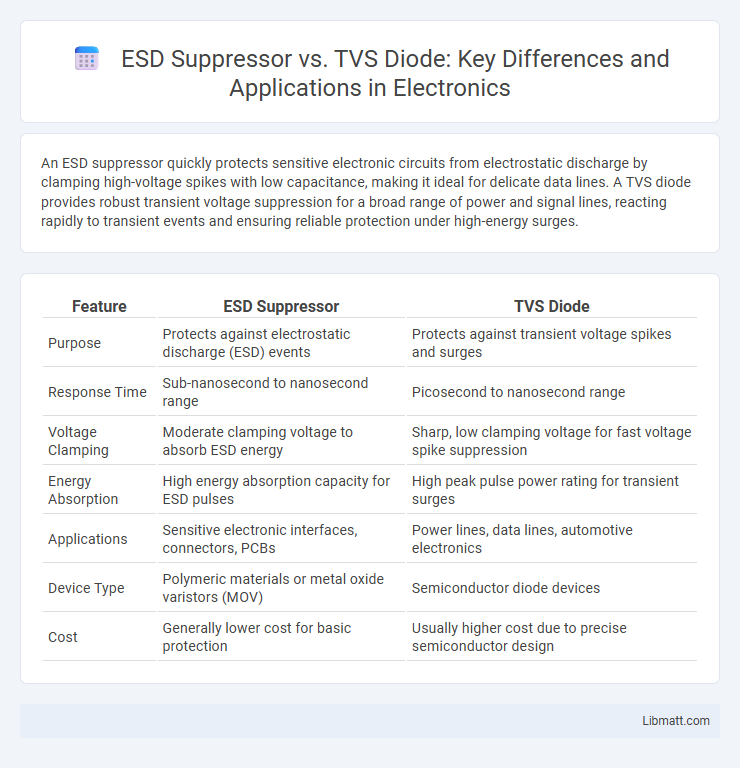An ESD suppressor quickly protects sensitive electronic circuits from electrostatic discharge by clamping high-voltage spikes with low capacitance, making it ideal for delicate data lines. A TVS diode provides robust transient voltage suppression for a broad range of power and signal lines, reacting rapidly to transient events and ensuring reliable protection under high-energy surges.
Table of Comparison
| Feature | ESD Suppressor | TVS Diode |
|---|---|---|
| Purpose | Protects against electrostatic discharge (ESD) events | Protects against transient voltage spikes and surges |
| Response Time | Sub-nanosecond to nanosecond range | Picosecond to nanosecond range |
| Voltage Clamping | Moderate clamping voltage to absorb ESD energy | Sharp, low clamping voltage for fast voltage spike suppression |
| Energy Absorption | High energy absorption capacity for ESD pulses | High peak pulse power rating for transient surges |
| Applications | Sensitive electronic interfaces, connectors, PCBs | Power lines, data lines, automotive electronics |
| Device Type | Polymeric materials or metal oxide varistors (MOV) | Semiconductor diode devices |
| Cost | Generally lower cost for basic protection | Usually higher cost due to precise semiconductor design |
Introduction to ESD Suppressors and TVS Diodes
ESD suppressors and TVS diodes both protect sensitive electronics from voltage spikes, but they operate differently. ESD suppressors are designed to absorb and dissipate electrostatic discharge energy, preventing damage during sudden static events. TVS diodes react rapidly to transient voltage surges by clamping the voltage and diverting excess current away from your components, ensuring reliable circuit protection.
What is an ESD Suppressor?
An ESD suppressor is a protective device designed to absorb and dissipate electrostatic discharge (ESD) energy, preventing damage to sensitive electronic components. Unlike TVS diodes, which clamp high-voltage spikes quickly, ESD suppressors often use resistance and capacitance to limit voltage surges over a wider frequency range. These suppressors are critical in safeguarding consumer electronics, telecommunications equipment, and automotive electronics from sudden electrostatic events.
What is a TVS Diode?
A TVS diode (Transient Voltage Suppressor diode) is a semiconductor device designed to protect electronic circuits from voltage spikes and transient surges by clamping excessive voltage to a safe level. It responds rapidly to transient events such as electrostatic discharge (ESD), lightning surges, and switching transients, effectively preventing damage to sensitive components. Unlike general ESD suppressors, TVS diodes offer precise voltage clamping with fast response times and are widely used in power lines, communication interfaces, and automotive electronics for transient voltage protection.
Key Differences Between ESD Suppressors and TVS Diodes
ESD suppressors are designed primarily for protecting sensitive electronic components from rapid, high-energy electrostatic discharge events by clamping voltage spikes, while TVS diodes provide fast response to overvoltage transients and are often used for continuous transient voltage suppression. ESD suppressors typically feature low capacitance and are optimized for high-frequency signal integrity, making them suitable for data lines, whereas TVS diodes handle higher energy and are commonly applied in power circuits for robust surge protection. The key differences lie in their response times, energy absorption capabilities, and typical application areas, with ESD suppressors focusing on electrostatic discharge scenarios and TVS diodes providing broader transient voltage safeguarding.
Working Principle: ESD Suppressor vs TVS Diode
ESD suppressors absorb and dissipate sudden electrostatic discharges by providing a low-resistance path to ground, protecting sensitive electronics from voltage spikes. TVS diodes clamp transient voltage surges by rapidly switching to a conductive state, shunting excess energy away from your circuits. Both devices rely on fast response times but differ in construction and application focus within electrostatic protection strategies.
Application Areas for ESD Suppressors
ESD suppressors are widely used in consumer electronics, automotive systems, and telecommunications to protect sensitive components from sudden electrostatic discharges. Their application areas include interfaces such as USB ports, HDMI connectors, and antenna terminals where high-frequency signals require minimal signal distortion. These suppressors offer reliable protection in environments prone to frequent handling or exposure to static electricity, ensuring device longevity and performance stability.
Application Areas for TVS Diodes
TVS diodes are widely utilized in protecting sensitive electronics in automotive systems, telecommunications equipment, and consumer electronics from transient voltage spikes. They are essential in circuit protection for power supply lines, data interfaces, and signal lines where fast response to voltage surges is critical. Their application extends to industrial automation and medical devices, ensuring device longevity and system reliability in high transient environments.
Performance Comparison: Speed, Clamping, and Longevity
ESD suppressors typically offer faster response times and lower clamping voltages compared to TVS diodes, making them ideal for protecting sensitive electronics from sudden electrostatic discharges. TVS diodes, however, provide robust energy absorption with higher surge current capabilities, ensuring longer operational longevity in harsher environments. Your choice depends on the required balance between rapid clamping performance and durable surge protection for your specific application.
How to Select the Right Device for Circuit Protection
Selecting the right device for circuit protection between an ESD suppressor and a TVS diode depends on the specific transient voltage requirements and response time of your application. ESD suppressors excel in handling high-frequency electrostatic discharges with fast clamping capabilities, while TVS diodes provide robust protection against high-energy voltage spikes and surges. Your choice should consider the maximum voltage rating, clamping voltage, and the nature of the transient threats to ensure optimal circuit reliability and longevity.
Summary: Choosing Between ESD Suppressor and TVS Diode
Choosing between an ESD suppressor and a TVS diode depends on the specific application requirements for transient voltage protection. ESD suppressors excel in clamping extremely fast electrostatic discharge events with minimal leakage current, making them ideal for sensitive electronic circuits. In contrast, TVS diodes offer robust protection against high-energy transient voltage spikes and are favored for general surge protection in power lines and data interfaces.
ESD Suppressor vs TVS Diode Infographic

 libmatt.com
libmatt.com